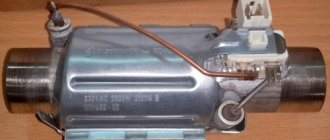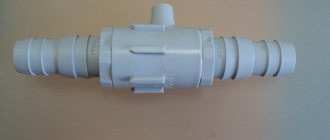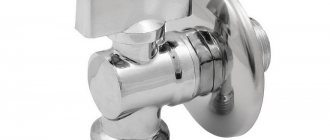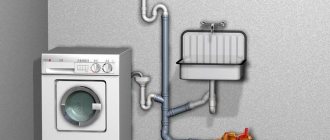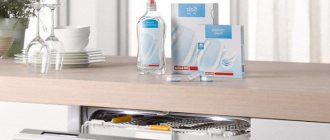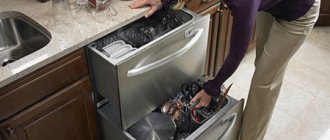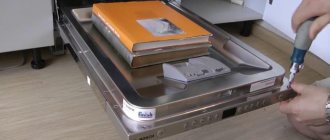Today, the popularity of dishwashers (hereinafter also referred to as dishwashers, PMM) is growing: more and more people are installing them in their kitchens. But not all owners know how to connect a dishwasher to communications.
The new dishwasher saves owners from manually washing dishes
Of course, you can call a specialist who, for a fee, will connect the new equipment to the electrical network, water supply and sewerage. But owners who have a minimum set of tools and certain skills can connect the dishwasher to the water supply and sewer system themselves. The connection is carried out in several stages, including preparatory stages. Let's take a closer look at them.
Choosing a location
You need to choose the location of the equipment before purchasing the PMM. If you decide to build a dishwasher into your kitchen furniture, you need to know the dimensions of the corresponding niche. It can be located under the countertop, cooking panel or under the sink .
Approximate size ratio of niche and built-in dishwasher
The place to install the dishwasher should be close to the sink , which is already connected to the water supply and sewerage system. If the distance to communications exceeds 1.5 meters, problems may arise in the operation of the device.
Washing machine and dishwasher built next to the sink
Make sure that there is an electrical outlet . Since the dishwasher consumes quite a lot of electricity, it is dangerous to use an extension cord to operate the PMM, especially if several devices will be connected to it.
The extension cord must not be placed behind the rear wall of the PMM
For a compact dishwasher that can be placed directly on the countertop, the issue of supplying communications is easier to solve, since it can be easily placed as close to the sink as possible. This option is optimal when there is no niche with the required dimensions in the furniture. There is no need to make a connection to the sewer at all; just place the drain hose in the sink.
Prices
Many people are interested in the price of a siphon for a car. The cost of this product will be influenced by factors such as material, brand (how well known), and the presence of additional functions. As a rule, the simpler the siphon for a dishwasher, the lower its cost. Here you should choose based on the cost of the machine itself. If it is expensive, then the siphon should be expensive, but if the product is from a budget class, then the siphon for it should be chosen the same.
In general, the price of a cheap siphon is about 1000 rubles, a more expensive model will cost about 5-7 thousand rubles. Accordingly, the more expensive the siphon model itself, the longer its service life will be. Also, a high price will indicate no less high quality. And quality is a very important thing for any buyer. But if the siphon breaks down, you don’t always have a certain amount in your pocket for an expensive siphon. Then you have a choice: stop using the machine until your financial situation is favorable, or purchase the siphon for which you have enough money.
Electricity supply
The main power in the dishwasher is consumed by a tubular electric heater (hereinafter also referred to as heating element), which heats the water to the desired temperature. During its operation, the PMM consumes from 2 to 3 kW of electricity. You can find out about this from the technical documentation or see this parameter on a sticker located on the machine body (see photo below).
The label indicates the power of the Hansa compact PMM - 1.93 kW
In accordance with these indicators, the outlet must withstand a current of at least 16 A. Moreover, it must be located in a place to which there is easy access. There are two placement options: slightly above the furniture countertop (in the case of a built-in PMM) or in an adjacent niche, while the distance to the sink should be at least 0.5 m (due to possible water ingress). One more rule must be observed: the outlet should be located no further than 1 m from the dishwasher.
The ideal layout of communications is shown in the figure below, where:
- PMM housing.
- Area of connection to the electrical network.
- The area where the PMM connects to the water supply system.
- Drainage area.
Diagram of the correct connection of the dishwasher to communications
A dedicated line must go to the outlet from the distribution panel. If it is not laid, and the apartment has already been renovated, run the wire along the wall and cover it with a decorative box. At the same time, the appearance of the interior will not be affected. The same line can be used to connect a washing machine, provided that it does not turn on at the same time as the PMM.
One of the options for connecting the dishwasher to the mains
For installation, you need to use a cable with stranded copper conductors (for example, brand VVG-nG-Ls) with a cross-section of 2.5 mm2. A residual current device (hereinafter also referred to as RCD) must be present, along with circuit breakers that operate at a current of 16 A. By the way, RCDs and circuit breakers can be replaced with one differential circuit breaker.
The need to install these devices is due to the fact that there is a danger of a short circuit in the electrical network with water and electric shock to people.
RCD and differential circuit breaker
Parameters of the protective device: 25 A, shutdown current - 10 mA. You can use an RCD with 16 A and 30 mA leakage current. The connection is performed in the same way for PMMs of a wide variety of brands: Bosch, Siemens, Electrolux, Indesit, Whirpool and others.
Bottom line
In conclusion, we should once again say about care when choosing a siphon, as well as about the accuracy of its installation. Don't forget to clean the siphon. It is required not only if the siphon is installed under a sink or bathtub, but also if it is installed in a washing machine or dishwasher. The performance of the machine as a whole will depend on how accurately and often you clean it.
Remember, repairing these household appliances will not be cheap. Therefore, you need to try to monitor the cleanliness of dishwashing equipment now. There are special detergents that will help keep your machine running for many years.
Instructions for connecting to the water supply
As a rule, flexible hoses from pipes with hot and cold water go to the mixer tap located in the sink. That is why the most convenient way to connect the PMM is located in the place where such a hose is connected to the water main. Otherwise, you will have to make a tap into the pipe using a tee or a manifold with two bends and taps. When connecting a flexible hose to a water supply, a tee with a shut-off valve must be installed under the sink.
Connecting a tee at the junction of a flexible hose with a water main coming out of the wall
A shut-off valve in the tee is necessary so that you can quickly stop the water supply in case of an emergency. Since most PMM models only require cold water, one tee will be required.
For work, you should prepare the following tools and materials:
- a tee with a built-in faucet, made of brass or bronze, with a thread diameter of 3/4 inch (this diameter is suitable in most cases);
- inlet coarse filter (if one is not included in the dishwasher kit);
- fluoroplastic sealing tape (FUM tape);
- adjustable wrenches;
- sharp knife.
2-output splitter with 3/4" thread diameter
If the kitchen already has a washing machine or plans to install one, the tee should be replaced with a manifold with two outlets with the same diameter (3/4 inch) and two shut-off valves (see photo above). In addition, some PMM models are equipped with inlet hoses that are too short, a little more than a meter long. If this length is not enough, you will have to buy a new hose from a specialized store.
PMM inlet hose together with the built-in Aquastop system
To properly connect the dishwasher to the water supply with your own hands, the work should be done step by step, in several stages:
- Shut off the water supply to the apartment.
- Disconnect the flexible hose supplying cold water to the faucet from the water supply pipe.
- Connect the water pipe to the inlet of the tee or splitter by first winding FUM tape onto the thread.
- Connect the outlet of the tee or manifold to a flexible hose going to the mixer. Don't forget to use FUM tape.
- Connect the filter and dishwasher inlet hose to one of the side outlets.
- If you have a washing machine, connect its inlet hose to the second outlet of the splitter.
- Check the tightness of all connections by supplying water to the main line.
This completes the connection of the dishwasher to the water.
It happens that when installing a dishwasher you have to redo the fastening and supply of communications
Sometimes the situation does not allow installing a PMM near the sink. In this case, you have to crash into the water pipe. If it is made of metal-plastic, there will be no difficulties. It is necessary to cut out a piece of pipe and install a tee or manifold with press fittings in its place to ensure a reliable connection.
Push-in connection of metal-plastic pipes using compression press fittings
There is no need to cut the metal pipe - just put a clamp with an outlet on top and drill a hole in the pipe through the outlet. This connection is also reliable.
Tee clamps for metal pipes, with attached shut-off valves
Connection between drain and sewer
If the dishwasher is installed next to a sink, you should pay attention to the siphon, which drains liquid from the sink into the drain. If there are no free outlets in it, you need to purchase a siphon with one additional outlet or two from a plumbing store (if you also need to connect a washing machine).
Siphon with two outlets for washing machine and dishwasher
The bends are equipped with conical fittings shaped like an inverted V (see photo). This form is not accidental. The upward bend prevents the spread of odors from the sewer and also prevents the reverse flow of liquid from the sewer into the PMM.
Connecting the PMM to the sewer through a tee
There is also the option of direct connection to the pipe through a tee with an oblique outlet (see photo). To organize the upper bend of the drainage hose, a special device is used that can be attached to the wall. To prevent unpleasant odors from penetrating into the room, a sealing sleeve made of rubber should be installed at the junction of the tee and the drain hose.
Finally, you should check the tightness of all connections , connect the dishwasher to the electrical outlet and turn it on for the first time. It should be done without utensils. To wash the hopper, you need to use special cleaning tablets or a cleaning and disinfectant for PMM. Only after turning it on for the first time can the dishwasher be installed in a furniture niche.
As you can see, you can connect to communications yourself. We hope that our article will help you complete this job.
Siphon operating principle
The siphon is the part of the sink drain that connects it to the sewer pipe. This device is made from materials that are resistant to chemical compounds and high temperatures, so it does not deform and, when assembled correctly, protects household appliances from leaks and sewage systems from frequent contamination and breakdowns due to the influence of aggressive environments.
How does a siphon work? During the draining of water, some of it is retained in the reservoir or sump of the device, due to which a water plug is formed, which prevents sewer gases and unpleasant odors from getting from the pipes into the room. Large waste is retained at the bottom of the device and can be easily removed from the product. Thus, the siphon protects the sewer from blockages and the machine from breakdowns, and allows you to clean the sewer pipes much less frequently with special means.

